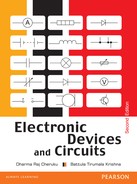Contents
1.2 Applications of electronics
2.4 Classification of materials
2.5 Intrinsic and extrinsic semiconductors
2.6 p- and n-type semiconductor materials
2.8 Properties of semiconductor materials
2.9 Hall effect and its applications
2.11 Time variation of excited minority carriers
2.12 Concept of diffusion current
2.13 Continuity equation in semiconductors
2.14 Injected minority carriers
2.15 Graded semiconductor junction
Chapter 3 Semiconductor Diodes
3.3 The current components in a junction diode
3.4 V-I characteristics of a diode
4.3 Comparison of types of rectifiers
Chapter 5 Bipolar Junction Transistors
5.6 Current components in a transistor
5.7 Transistor as an amplifier
5.8 V-I characteristics of a transistor
5.10 Common emitter configuration
5.11 Common collector configuration
5.12 Ebers-moll model of a transistor
5.13 Voltage ratings of a transistor
5.14 Typical junction voltages
6.2 Load line and operating point
6.4 Stability of operating point
6.11 Concept of thermal runaway
Chapter 7 Transistor Amplifier Circuits
7.2 Large signal analysis of transistor amplifier
7.3 Two-port model of a transistor
7.4 Small signal low-frequency model of a transistor
7.5 Analysis of a transistor amplifier circuit
7.6 Transistor amplifier configurations
7.7 Linear analysis of a transistor circuit
7.8 Miller’s theorem and its applications
7.9 Simplified model of a transistor
7.10 CE amplifier with emitter resistance
7.12 Frequency response of an amplifier
7.13 Bandwidth of a cascaded amplifier
7.16 High-frequency model of a CE transistor
7.17 Validity of the high-frequency model
7.18 High-frequency current gain
Chapter 8 Field Effect Transistors
8.3 Drain and transfer characteristics of a JFET
8.4 Small signal model of a FET
9.3 Silicon-controlled rectifier
Chapter 10 Feedback Amplifiers
10.2 Types of distortion in amplifiers
10.4 Negative feedback in amplifiers
10.5 Transfer gain with feedback
10.6 Advantages and disadvantages of negative feedback
10.7 Effect of feedback on input and output impedances
10.8 Analysis of feedback amplifiers
10.9 Voltage series feedback amplifier
10.10 Current series feedback amplifier
10.11 Current shunt feedback amplifier
10.12 Voltage shunt feedback amplifier
Chapter 11 Sinusoidal Oscillators
11.4 Resonant circuit oscillator
11.5 Hartley and Colpitt oscillators
11.8 Amplitude and frequency stability
12.2 Types of power amplifiers
12.4 Class A series-fed amplifier
12.5 Class A transformer-coupled amplifiers
12.7 Class A push-pull amplifier
12.9 Other types of class B amplifiers
12.15 Instability in tuned amplifiers
Chapter 13 Operational Amplifiers
13.2 Characteristics of ideal Op-Amp
13.5 Error voltages and currents
13.7 Mathematical computations using Op-Amp
13.8 Converters and Comparators
Chapter 14 Cathode-ray Oscilloscope
14.2 Two-dimensional motion of electron
14.3 Force and motion in magnetic field
14.4 Parallel electric and magnetic fields
14.5 Perpendicular electric and magnetic fields
